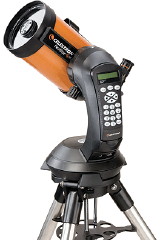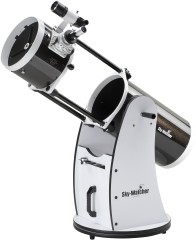If I had to choose one telescope
A question via Flickr:
If someone put a gun to your head and said, “choose a scope to use forever, the Equinox 80 or the NexStar 5,” which would it be? (I know they both have their own purposes, i.e., gazing or astrophotography, but I’m stuck with which one to buy!) So which would you use forever if you had no choice?
If I had to choose a telescope to use forever, it would probably be neither of these two telescopes, which are relatively inexpensive. If I won the lottery, one of the first things I would do is go out and buy a Tele Vue NP127is. Or an Obsession 18. Or, you know, both, because I just won the lottery. (This exercise is rendered substantially academic by the fact that I don’t buy lottery tickets.)
But if I was forced to choose between the two telescopes I have right now, I’d have to say that in all ways except aperture and price, the Equinox 80 is a better telescope than the NexStar 5 SE. But aperture and price aren’t nothing.
First, aperture: the more of it a telescope has, the more you can see through it. In astronomy, aperture rules. The NexStar 5’s aperture is 125 mm; the Equinox 80’s, 80 mm. A 125-mm telescope has 2.44 times the light-gathering power of an 80-mm telescope. (With the caveat that, as a Schmidt-Cassegrain, the NexStar 5 has a central obstruction; the Equinox 80, as a refractor, does not.) Things that are faint in the Equinox are brighter in the NexStar, and there are things that are visible in the NexStar that the Equinox cannot resolve. Aperture rules — but, truth be told, neither of these scopes is particularly well-endowed with it. In the grand scheme of things, these are small scopes.
Many people find the images more pleasing through an apochromatic refractor than they do through other scopes, like Schmidt-Cassegrains and reflectors. And, true enough, despite the lesser light-gathering power, I have to confess that if I can see an object in the Equinox, I prefer looking at it with the Equinox over the NexStar. Aperture be hanged, it’s just prettier. The fact that the Equinox has a shorter focal length makes it more useable during periods of poor seeing: there have been times when bad skies made viewing through the NexStar (focal length: 1250 mm) almost impossible, but I still got acceptable views through the Equinox (focal length: 500 mm).
Moving on to price, they’re both inexpensive scopes. They each cost around $800 (Canadian) nowadays, give or take a hundred (shop around). But the Equinox is more expensive, because with the NexStar, that $800 gets you, along with the optical tube, a computerized mount, a star diagonal, an eyepiece, and a red dot finder — all of which are extras with the Equinox. With the Equinox, the only extra is a case. A nice case, mind you, but you have to buy a bunch of other things before you can do anything.
 The NexStar is a good beginner’s scope; the Equinox isn’t. The NexStar comes with everything you need to start observing; the Equinox requires a lot of other stuff — with the presupposition that you already have that stuff.
The NexStar is a good beginner’s scope; the Equinox isn’t. The NexStar comes with everything you need to start observing; the Equinox requires a lot of other stuff — with the presupposition that you already have that stuff.
But, having said that, while the NexStar comes with a lot of stuff for that $800 (or so), you do get what you pay for. The star diagonal and eyepiece are serviceable, but better stuff is out there if you want to upgrade. It’s a go-to scope, and works well within certain expectations, but I’ve had better results from the go-to on my HEQ5 Pro equatorial mount (which, to be fair, cost me $1,300). And there’s no lock on the altitude axis, which means I can nudge it out of alignment really easily. The upshot is that we often have to do multiple alignments a night as a result of our clumsiness or the NexStar’s inaccuracies.
 On the other hand, the $800 (or so) for the Equinox 80 is almost entirely for the scope. The Equinox is a lustrous, finely machined instrument; it’s gorgeous in person. But it’s also a specialized instrument: it’s basically built for astrophotography — i.e., it’s an astrograph. It’s expensive overkill for purely visual use. Visual observers looking at the Equinox 80 would be better served, I think, with Sky-Watcher’s Black Diamond 80 ED refractor, which costs about the same, but comes with things like a finder, diagonal and eyepieces. Either way, you’d still have to come up with a mount, which can range from a few hundred to a thousand dollars, depending.
On the other hand, the $800 (or so) for the Equinox 80 is almost entirely for the scope. The Equinox is a lustrous, finely machined instrument; it’s gorgeous in person. But it’s also a specialized instrument: it’s basically built for astrophotography — i.e., it’s an astrograph. It’s expensive overkill for purely visual use. Visual observers looking at the Equinox 80 would be better served, I think, with Sky-Watcher’s Black Diamond 80 ED refractor, which costs about the same, but comes with things like a finder, diagonal and eyepieces. Either way, you’d still have to come up with a mount, which can range from a few hundred to a thousand dollars, depending.
It’s important for my correspondent to keep in mind that I bought these telescopes for specific reasons. I bought the NexStar as a first-time scope because, more than anything else, it was portable: I wanted to be able to haul it, as a single piece, over several hundred metres, because that’s what it took to get to the observing site. I bought the Equinox for astrophotography.
 But if I had $800 now and was largely interested in visual work, I might buy a Dobsonian: Sky-Watcher’s 10-inch collapsible Dobsonian can be had for $800 or less in most Canadian telescope stores. Lots of aperture: four times the light-gathering power of the NexStar 5; 10 times that of the Equinox 80. Suffice to say, you’d see stuff. And experience has taught me that go-to can be fiddly and frustrating; sometimes you just want to do it manually. It’s not a perfect scope, and the reviews have pointed out some quirks with it (such as a slightly too-small secondary mirror) and the rest of Sky-Watcher’s collapsible line, but with a Dobsonian you get more aperture for the same amount of money than any other option.
But if I had $800 now and was largely interested in visual work, I might buy a Dobsonian: Sky-Watcher’s 10-inch collapsible Dobsonian can be had for $800 or less in most Canadian telescope stores. Lots of aperture: four times the light-gathering power of the NexStar 5; 10 times that of the Equinox 80. Suffice to say, you’d see stuff. And experience has taught me that go-to can be fiddly and frustrating; sometimes you just want to do it manually. It’s not a perfect scope, and the reviews have pointed out some quirks with it (such as a slightly too-small secondary mirror) and the rest of Sky-Watcher’s collapsible line, but with a Dobsonian you get more aperture for the same amount of money than any other option.
And, funnily enough, Jennifer and I have been talking about a 10-inch Dob lately …